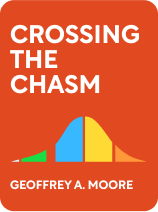

This article is an excerpt from the Shortform book guide to "Crossing the Chasm" by Geoffrey Moore. Shortform has the world's best summaries and analyses of books you should be reading.
Like this article? Sign up for a free trial here .
What is the Diffusion of Innovation (aka TALC) model? How many categories of customers are there in the TALC framework?
The Diffusion of Innovation model (also known as the Technology Adoption Life Cycle) was developed by Beal and Bohlen, two agricultural extension agents working for Iowa State College in the 1950s. They developed the model based on studies of when farmers started using new agricultural innovations, such as fertilizer and hybrid seed corn. Others soon generalized the model to technological innovations outside of agriculture.
In this article, we’ll take a look at how the Diffusion of Innovation Model explains the adoption of new technology throughout the five stages of its maturity.
The Diffusion of Innovation Model Explained
The Diffusion of Innovation model predicts that as a technology matures, the number of potential new buyers first increases (as the technology starts to catch on) and then decreases (as you run out of potential customers who haven’t already bought it), following the profile of a bell curve.
The area under the curve represents the total number of customers for the new technology. This area is divided into five psychographic categories (classifications by psychological and demographic criteria) of prospective customers, as shown in the figure below.
Psychographic Categories of Customers
The Diffusion of Innovation model divides customers into five categories based on their “psychographics,” the combination of psychology and demographics that dictates their purchasing behavior. These categories are:
- Innovators are the first to buy new technology. According to Moore, they love new technology just because it’s new technology, but they’re often on a limited budget because they usually work highly technical jobs, rather than positions in upper management.
- Early Adopters are the second group to buy new technology. According to Moore, early adopters are usually visionary business managers: They don’t value new technology for its own sake, but they have enough technical insight to identify the strategic advantages that new technology can provide.
- The Early Majority are the third group to adopt new technology. According to Moore, they are pragmatic people, who are interested in leveraging new technology to improve their business, but also averse to the risks of unproven technologies. They are less technically inclined than innovators or early adopters, and tend to measure a high-tech product more by industry standards and the product’s reputation than by direct assessment of the underlying technology.
- The Late Majority are the fourth group to adopt new technology. According to Moore, they are more conservative and less technically competent than the early majority: They’re not interested in getting ahead with technology, but they don’t want to fall behind.
- Laggards do not adopt new technology willingly. If they adopt it at all, it will be old technology by the time they do.
| Category Boundaries According to Geoffrey Moore, the author of Crossing the Chasm, the boundaries between the five psychographic categories of the TALC lie approximately at the standard deviation intervals on the bell curve. (Most of the area under a normal bell curve lies within three standard deviations of the center, so in this case, the standard deviation intervals essentially divide the graph into six equally spaced regions along the horizontal axis.) However, the graph that Moore presents in Crossing the Chasm depicts the boundaries considerably further from the center of the curve than standard deviation intervals would be. This makes the early and late majorities appear to represent a larger proportion of the overall population. Moore provides no explanation for the discrepancy in the graph, so presumably his graphic artist simply didn’t draw it to scale. In our figure above, the boundaries are marked at the standard deviation intervals, consistent with Moore’s assertion. However, other analysts have challenged the proportions of the population allotted to each category. Some argue that with the accelerating pace of technological innovation, the peak of the bell curve has shifted to the left, meaning that today there are proportionately more people in the early majority and early adopter categories, and fewer people in the late majority. |

———End of Preview———
Like what you just read? Read the rest of the world's best book summary and analysis of Geoffrey Moore's "Crossing the Chasm" at Shortform .
Here's what you'll find in our full Crossing the Chasm summary :
- An explanation of the chasm phenomenon that many new high-tech products face
- How to pilot a product across this chasm to mainstream success
- The problems with the Technology Adoption Life Cycle (TALC) model






